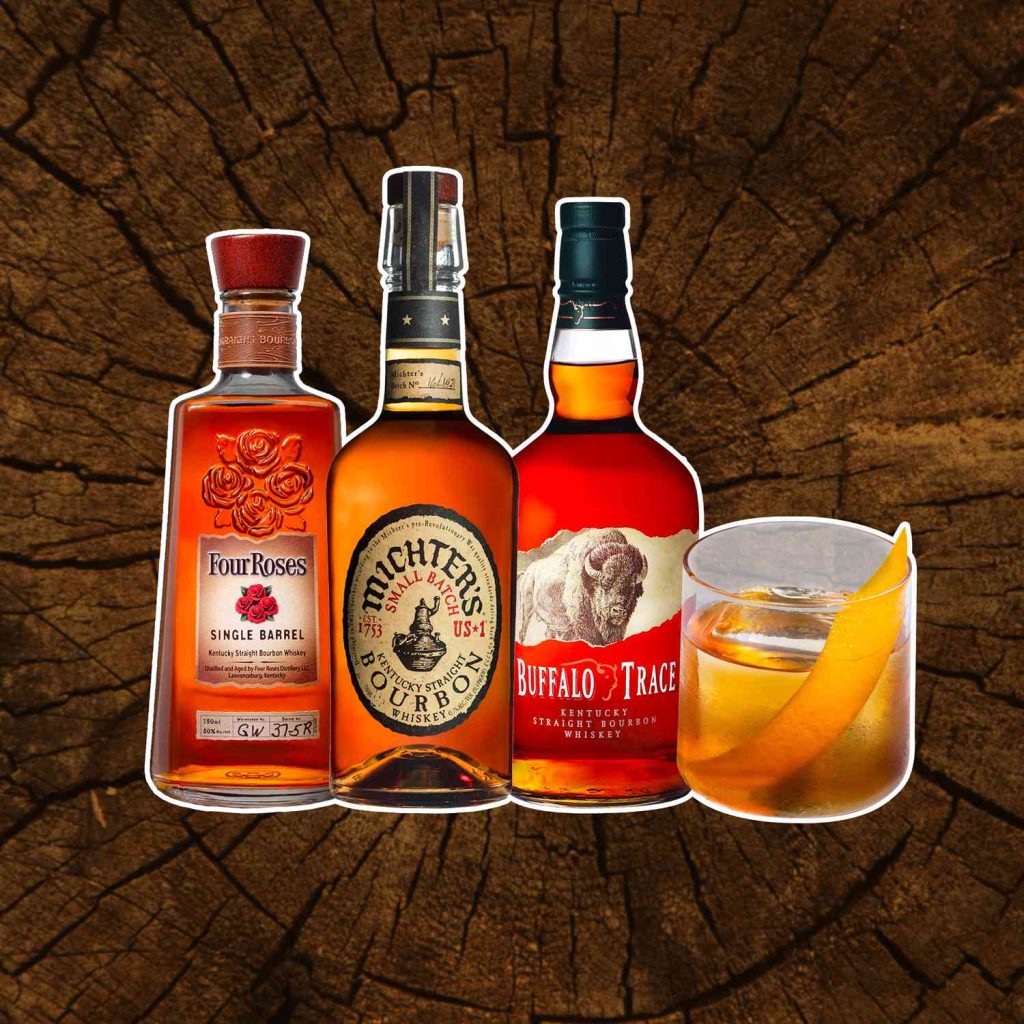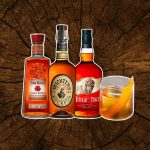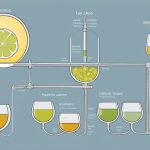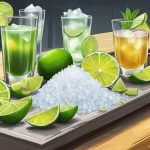Bourbon, an American style of whiskey, is celebrated for its rich and complex flavor profile that arises from its unique distillation process and aging in charred oak barrels. The spirit’s taste is influenced by factors such as the grain mix, the quality of the water used, and the duration of aging, with the final product embodying a balance of sweet, spicy, and woody notes. Often associated with the southern United States, particularly Kentucky, bourbon‘s signature characteristics have earned it a celebrated spot in the world of spirits.

When sipping bourbon, one is likely to identify flavors of vanilla, caramel, and oak, with hints of fruit or floral notes depending on the specific brand. The distinct taste of bourbon can vary greatly from one distiller to another, with some being more mellow and sweet, while others offer a spicier kick, reflecting the diversity of bourbon’s flavor canvas. It’s a spirit that invites connoisseurs and casual drinkers alike to explore its depths, whether enjoyed neat, on the rocks, or as the foundation of a classic cocktail.
Key Takeaways
- Bourbon is an American whiskey known for a complex flavor profile.
- The taste of bourbon can vary, featuring vanilla, caramel, and oak notes.
- Bourbon’s diversity in flavor makes it popular for drinking neat or in cocktails.
Table of Contents
History and Origin
Bourbon, often known as “America’s Native Spirit,” has its roots steeped in early American history. It is a type of whiskey with a distinctive taste that can be attributed to its unique production process and the geographical area where it originated.
Early Distillation
Distillation of bourbon began in the late 18th century when European settlers, including the Scots and Irish, brought their whiskey-making knowledge to the American frontier. Early distillation methods employed by these settlers in Kentucky, which was then part of Virginia, utilized the abundant crops of corn. Over time, these methods evolved into the precise craft of making bourbon whiskey.
Geographical Significance
Kentucky plays a pivotal role in the history of bourbon due to its natural resources that contribute to the spirit’s unique flavor profile. The limestone-filtered water provides an ideal mineral-rich base for the mash. Kentucky’s climate, with its hot summers and cold winters, is perfect for aging bourbon, allowing the whiskey to expand and contract within the oak barrels, which imbues it with rich, nuanced flavors.
Understanding Bourbon
Bourbon offers a distinct taste experience defined by specific standards and processes. This section explains the legal requirements, primary ingredients, distillation process, and how maturation and aging contribute to bourbon’s unique flavor.
Legal Requirements
By law, bourbon must be made in the United States and contain at least 51% corn in its mash bill. It must be distilled to no more than 160 proof (80% alcohol by volume) and entered into the barrel for aging at no more than 125 proof (62.5% alcohol by volume). Additionally, aging must occur in new, charred oak barrels, with no additives to enhance flavor or color.
Primary Ingredients
The cornerstone of bourbon is its grain mix, consisting predominantly of corn, which lends sweetness to the flavor. Secondary grains often include wheat, rye, and barley. Wheat can soften the taste, while rye adds a spicy note, and barley contributes to the fermentation process.
Distillation Process
Bourbon undergoes a careful distillation process to separate the alcohol from the mash. It begins with the creation of a mash by combining grains, water, and yeast, leading to fermentation. After fermentation, the mixture is heated, allowing for alcohol vapors to be captured and condensed into a liquid form.
Maturation and Aging
New, charred oak barrels, typically made from American oak, are essential for bourbon’s aging process. The aging must take place under controlled environmental conditions. The char on the inside of the barrels imparts flavor and a rich color to the bourbon. Maturation allows complex flavors to develop over time, with a minimum aging period for straight bourbon being two years.
Bourbon Flavor Profile: What Does Bourbon Taste Like?
Bourbon’s distinct flavor is a symphony of aromas, tastes, and sensations, creating a unique experience with every sip. Its profile is shaped by specific ingredients and aging processes, resulting in a variety of characteristic notes that range from sweet to spicy.
Aroma Characteristics
The initial encounter with a bourbon is its aroma, which can prelude the richness of its flavor. A blend of vanilla, caramel, and oak often defines the first impression. These are sometimes accompanied by lighter floral notes, fruit nuances, and a touch of tobacco or leather, revealing the complexity and depth before it ever touches the palate.
Taste Components
As bourbon coats the tongue, its taste components reveal themselves. There’s an evident sweetness derived from the corn base, balanced by the spiciness of rye. Subtle notes of cinnamon, honey, and a nutty character may also come through. Fruity notes are not uncommon, adding a layer of complexity to the main flavor profile that bourbon aficionados cherish.
Finish and Aftertaste
The experience of bourbon is capped by its finish — the lingering flavors that remain after swallowing. The finish can last from a few moments to several minutes, often leaving a warm spicy or smoky aftertaste, accentuated by the aforementioned vanilla, caramel, and oak. The quality and length of the finish are essential to the overall appreciation of the bourbon flavor profiles.
Tasting Bourbon
When one sets out to taste bourbon, the experience involves both the preparation, including glassware choice, and the actual process of savoring the drink. Each element plays a crucial role in unfolding the complex flavors of bourbon.
How to Taste Bourbon
Tasting bourbon is an art that involves several steps. At its core, bourbon should be tasted neat to appreciate its true essence. A taster begins by observing the color, noting that a darker hue may indicate a richer flavor profile. After swirling the bourbon gently in the glass, they should take in the aroma before taking a small sip. Holding the bourbon in the mouth allows the tasting notes to come forward. Here are the broad steps to taste bourbon:
- Look: Examine the bourbon’s color and consistency.
- Swirl: Gently swirl the glass to release the bourbon’s aromas.
- Sniff: Inhale the aromas deeply to identify any specific scents.
- Sip: Take a small sip, letting it coat the mouth.
- Savor: Note the initial flavors, the evolution on the palate, and the aftertaste, or finish.
By following a tasting guide, they can identify specific flavors such as sweetness from corn or vanilla from the charred oak barrels. Documenting these observations as tasting notes will help bourbon aficionados refine their palate over time.
Glassware
Selecting the right glassware is essential for an authentic bourbon tasting experience. The Glencairn glass is widely recommended for its tulip shape, designed to concentrate the aromas towards the top of the glass, enhancing the nosing process. The wide bowl allows for an ample surface area to swirl the bourbon, releasing its distinct flavors.
- Glencairn Glass: Ideal for concentrating aromas and highlighting nuances in the bourbon.
- Snifter: Another option that offers a similar bowl shape and nosing benefits.
In summary, using appropriate glassware like the Glencairn glass can significantly impact the ability to discern and enjoy the subtleties of bourbon’s flavor profile.
Bourbon in Cocktails
Bourbon brings a rich and versatile flavor to the world of cocktails. Its unique taste contributes to both the depth and the sweetness of the drinks it is mixed into.
Classic Bourbon Cocktails
-
Manhattan: A timeless cocktail combining bourbon, sweet vermouth, and bitters, often garnished with a cherry. This 25 Best Bourbon Cocktails Ranked list verifies its popularity.
-
Old Fashioned: requires just a few ingredients—bourbon, sugar, and bitters—to create a sophisticated, yet simple drink.
-
Mint Julep: A southern classic prominently featuring bourbon, sugar, mint, and crushed ice, particularly famous for its association with the Kentucky Derby.
-
Whiskey Sour: A tart and refreshing mix of bourbon, lemon juice, and sugar; often served with a slice of orange or a cherry.
Whether one prefers the simplicity of an Old Fashioned or the elegance of a Manhattan, bourbon is clearly a spirit that holds a prestigious place in the craft of mixology.
Types and Varieties
Bourbon is a diverse spirit with several types that offer distinct flavor profiles. These varieties are primarily distinguished by their mashbill—the mix of grains used to produce them.
Traditional Bourbon
Traditional bourbon is known for a mashbill that typically contains about 70-80% corn, with the remainder being a mixture of malted barley and rye. This classic grain combination imparts flavors like vanilla and caramel, staples of the bourbon taste profile due to the aging process in charred oak barrels.
Wheated Bourbon
Wheated bourbon substitutes rye with wheat, giving the spirit a softer, smoother palate. The presence of wheat allows for a sweeter and more mellow profile, often with hints of honey, bread, or biscuits. This type of bourbon is well-suited for those who prefer a less spicy whiskey.
High-Rye Bourbon
As the name suggests, high-rye bourbon features a greater proportion of rye grain in its mashbill, often around 15-35%. This results in a spicier and more robust flavor, with notes of pepper and baking spices. Fans of a bolder taste tend to lean towards high-rye bourbons for their distinctive kick.
Selecting a Bourbon
When one is in the market for a bourbon, understanding labels and knowing about popular brands can help make an informed choice. These key elements guide consumers to a bourbon that suits their taste preferences and occasions.
Reading Labels
Bourbon labels contain crucial information, including age statements, proof, and mash bill. The age statement tells how long the bourbon has aged, influencing its flavor complexity. Proof indicates alcohol content, with higher proof often equating to bolder taste. The mash bill shows the grain composition, crucial for flavor; bourbons with higher rye content, for instance, tend to be spicier.
Popular Brands
Navigating through bourbon brands can be daunting, but certain names stand out:
- Buffalo Trace stands as a well-known brand offering rich history and consistent quality.
- Maker’s Mark is recognized for its smoothness and approachable profile, often recommended for those new to bourbon.
- Larceny presents a sweeter experience with its wheat-based mash bill.
- Blanton’s, known for its single-barrel production, delivers unique and complex flavors in each bottle.
- Bulleit has a high rye content, making it an excellent pick for those enjoying a spicier taste.
Each brand has its characteristics, and they often cater to different taste preferences and price points, helping consumers find a bourbon that fits their individual palate.
Responsible Consumption
When enjoying bourbon, which is a type of spirit with a significant alcohol by volume (ABV) typically around 40% to 50%, it’s important to consume it responsibly. Spirits like bourbon are stronger than beer or wine, so smaller amounts go a long way.
-
Know Your Limit: Each person’s body handles alcohol differently. It’s advised that men should not exceed two drinks per day and women should limit themselves to one.
-
Measure Accurately: A standard drink of bourbon is 1.5 ounces. Use a shot glass or a jigger to ensure proper measurement.
-
Savor Slowly: Bourbon is meant to be sipped and savored, not consumed quickly. Enjoy the complex flavors that each sip offers.
-
Don’t Drive: Never operate a vehicle after drinking bourbon. Alcohol impairs reaction times and judgement.
-
Hydrate: Alternate sips of bourbon with water. This helps maintain hydration and can reduce the effects of a hangover.
-
Eat First: Consuming bourbon on an empty stomach can lead to quicker intoxication. It’s wise to eat before you drink.
By following these guidelines, one can appreciate the rich taste of bourbon without the negative consequences of overconsumption. Always prioritize safety and well-being while drinking any alcoholic beverages.
Pairing and Culinary Uses
Bourbon, with its diverse flavor profile, serves as a versatile companion to many foods and is used in a range of culinary applications. Its unique taste can complement sweet and savory dishes alike.
Food Pairings
Bourbon’s richness and notes of vanilla and caramel make it a natural match for desserts like pecan pie or dishes that include roasted nuts. Its sweeter undertones can enhance the taste of smoked meats or barbecue, providing a balance to the savory flavors. When considering bourbon for food pairings, one should consider the flavor intensity of both the bourbon and the dish to achieve a harmonious balance.
- Sweet Treats: Bourbon pairs wonderfully with desserts that feature pecan, apple, or pear, where its sweetness complements the natural sugars of the fruits.
- Savory Dishes: A pour of bourbon can bring out the underlying sweetness in a slice of rich cornbread, or add complexity to a smoky barbecue sauce.
- Nuts & Snacks: The spirit’s nutty notes are great with snacks like roasted nuts, enhancing their richness.
- Fruits & Citrus: Bourbon’s citrus undertones can brighten up a dish featuring dried fruit, adding layers to its flavor palate.
- Wine Comparisons: While different from wine, bourbon can also be thoughtfully paired with foods in a similar manner, considering the balance of flavors.
It is important to consider the intensity of the bourbon’s flavor profile; lighter bourbons might suit seafood or salad dishes, while bolder, high-proof varieties can hold up against heavier foods like grilled meats.
Bourbon Industry Today
The bourbon industry has seen a rise in craft distilleries, along with a growing interest from the global market.
Craft Distillaries
Craft distilleries are changing bourbon’s future. These smaller operations focus on the ________ distillation process and unique aging methods to create distinct flavors. They often experiment with ingredients and techniques, putting innovative spins on traditional bourbon profiles. Consumers can find a range of tastes, from spicy to sweet, as these distilleries produce bourbons that challenge and excite the palate.
Global Market
Bourbon has rapidly expanded beyond its American roots, attracting a global audience. Brands now sell to ____________, appealing to diverse tastes and contributing to the drink’s international reputation. The global demand for bourbon creates opportunities for both established and new producers to widen their reach and introduce bourbon culture to consumers worldwide. This demand drives the industry to maintain a high standard in bourbon production, ensuring each bottle reflects the spirit’s rich heritage.
Advanced Topics
In exploring the deeper aspects of bourbon’s profile, one must consider the intricate chemistry that imbues it with flavor and the science behind its aging process.
Chemistry of Bourbon Flavors
The flavor of bourbon is a complex mixture of chemical components. It begins with the mash bill—the recipe of grains used to create the bourbon. Grains like corn, rye, and barley are rich in carbohydrates, which are converted into fermentable sugars through the action of enzymes. During fermentation, yeast metabolizes these sugars, creating alcohol and a variety of flavor compounds, including esters and aldehydes, which contribute fruity and nutty notes, respectively.
Further complexity is added through the distillation process, as the heated liquid allows certain flavor molecules to vaporize, condense, and become concentrated. Caramel notes mainly develop from the Maillard reaction, which occurs when sugars and amino acids combine under heat. Additionally, compounds like lignin in the wood give rise to vanilla and spice nuances.
Aging Process Science
Aging, or maturation, profoundly alters bourbon’s final flavor profile. Charred oak barrels play a pivotal role during this phase. The charring creates a layer of carbon that aids in the removal of unpleasant flavors and imparts a smoother character to the bourbon. Over time, the liquid expands and contracts with temperature fluctuations, allowing the bourbon to seep into the wood and extract flavors from the wood sugars.
The interaction with oak leads to the infusion of flavors such as vanilla, coconut, and caramel. The longer the bourbon ages, the more complex it can become. However, excessive aging can result in an overly-oaked flavor that may overpower the subtle notes developed in earlier stages. The science of barrel aging is a delicate balance, seeking the perfect harmony between the bourbon and the influences of time and timber.
Bourbon Collecting and Connoisseurship
Bourbon collecting is a rewarding hobby for those who appreciate fine spirits. The journey from novice to connoisseur involves learning about bourbon’s distinct flavors, which range from rich and bold to delicate and subtle.
Collectors often seek out straight bourbon, which is a type of bourbon that has been aged for at least two years and is free from added colors or flavors. These bottles can become highly sought-after collector’s items, with some commanding impressive prices.
Here’s how one can develop their bourbon collection:
- Identify Preferences: Start by tasting different types of bourbon to understand personal preferences.
- Research: Learn about what makes each bourbon unique, such as the aging process, distillery history, and mash bill.
- Purchase: Begin acquiring bottles that cater to those preferences and are known to be of good quality.
- Storage: Store bourbon in a cool, dark place to maintain its quality.
Collecting Tips:
| Tip | Explanation |
|---|---|
| Start Small | Build the collection slowly, starting with more accessible bottles. |
| Focus on Quality | Look for well-crafted bourbons rather than just rare ones. |
| Keep Records | Log purchase dates, prices, and tasting notes for each bottle. |
Bourbon connoisseurs understand that each bottle tells a story. They often share these stories and experiences, which adds a layer of enjoyment to their collection. As knowledge grows, so too does the ability to discern the intricate flavors and history behind each bottle.
Sustainability and Environmental Impact
Bourbon production relies heavily on natural resources, such as water, wood, and the oak barrels essential for aging the spirit. These resources have a substantial environmental impact, influencing the industry’s move toward sustainability.
-
Water Usage: It takes large amounts of water to produce bourbon. From cooking the grains to the distillation process, conservation efforts are necessary. Distilleries are now adopting strategies to reduce water usage and purify water before releasing it back into the environment.
-
Wood Requirements: To create bourbon, distilleries need oak wood for barrels. These barrels give bourbon its unique taste and color. However, sourcing wood impacts forests. The industry is responding by turning to sustainable forestry practices to ensure a balance between usage and replenishment.
-
Energy Consumption: Distilleries burn fossil fuels for energy, which emits greenhouse gases. Alternatives like solar and wind power are becoming more common, decreasing the carbon footprint of bourbon production.
Sustainable Practices:
- Energy-efficient equipment to lower energy needs
- Reusing and recycling materials, like water and grains
- Choosing renewable energy sources to power operations
Distilleries are leading the way with green initiatives to influence positive change. For instance, some have managed to greatly reduce energy use and water consumption while achieving carbon emission reductions and zero waste in landfills.
By integrating these sustainable practices, the bourbon industry is taking important steps to protect the environment. This careful management of resources helps ensure the future of bourbon production without compromising the planet.
Frequently Asked Questions
In exploring the world of bourbon, enthusiasts often seek to understand its unique flavor nuances and how it compares to other whiskeys. The following questions delve into the common queries surrounding the taste of bourbon.
How would you describe the flavor profile of bourbon?
Bourbon’s taste is typically rich and full-bodied, with an underlying sweetness due to the corn used in its production. Aging in charred oak barrels imparts notes of caramel, vanilla, and wood.
What are the characteristic differences in taste between bourbon and scotch?
Scotch often exhibits a smoky flavor, attributed to the peat used during malting, whereas bourbon tends to be sweeter and smoother, with a robust caramel and vanilla presence due to the new charred oak aging process.
Can one detect notes of sweetness in bourbon, and how does it compare to other spirits?
Sweetness in bourbon is more pronounced than in many other spirits, with manifest flavors like honey, butterscotch, and fruit, setting it apart from the more herbal or floral notes found in certain whiskies or clear spirits. Bourbon’s inherent sweetness is derived from its corn mash.
For newcomers to bourbon, what should they expect in terms of taste and smoothness?
Newcomers can expect a warm, smooth experience with a balanced sweetness. The smoothness of bourbon is often enhanced by the aging process, which mellows the spirit’s kick and adds complexity.
What are some common flavors and aromas found in the best-rated bourbon whiskeys?
The top-rated bourbons will often display a symphony of aromas like vanilla, caramel, oak, and cinnamon. One might also pick up hints of dark fruit, chocolate, and tobacco in the flavor profile.
How does the taste of bourbon enhance the flavor when used in cooking?
When bourbon is used in cooking, its rich flavors of vanilla and caramel complement and deepen savory and sweet dishes alike, adding a unique smoky note that can elevate a recipe’s overall taste profile.







